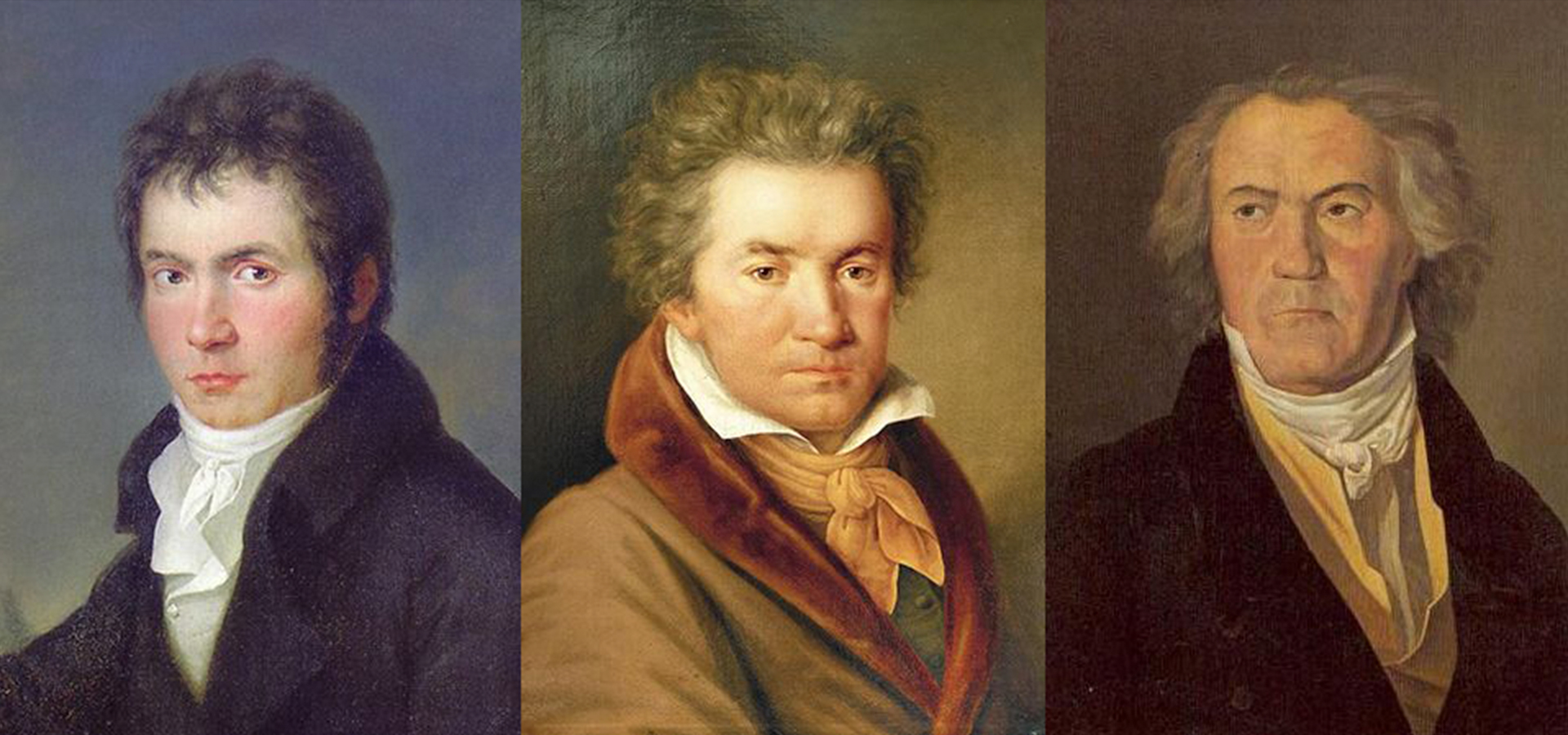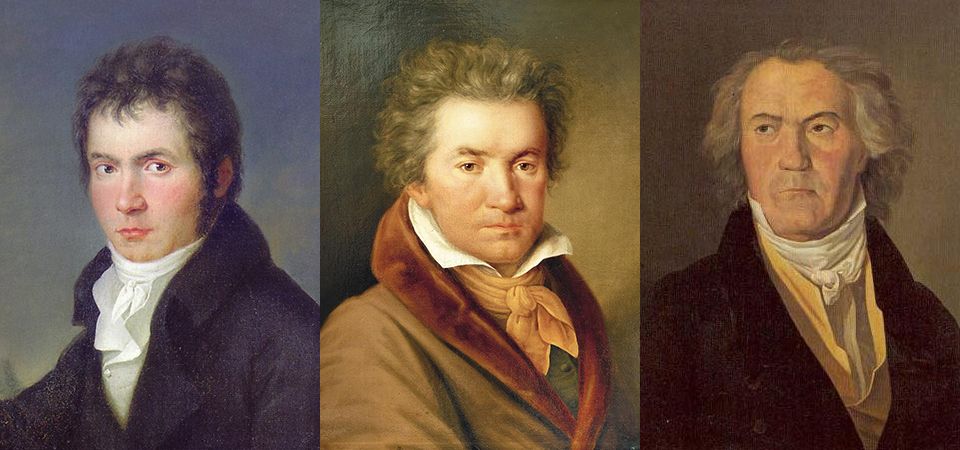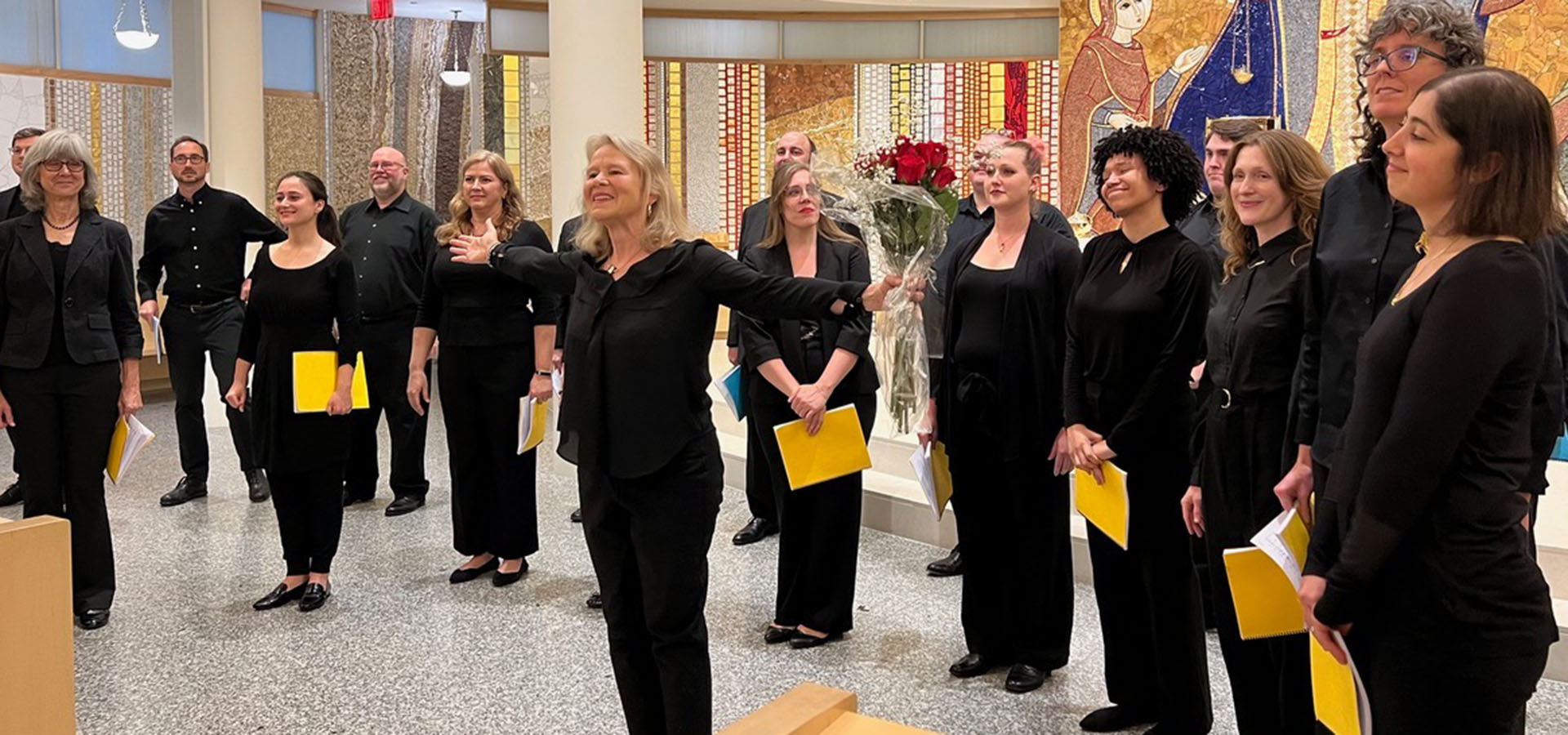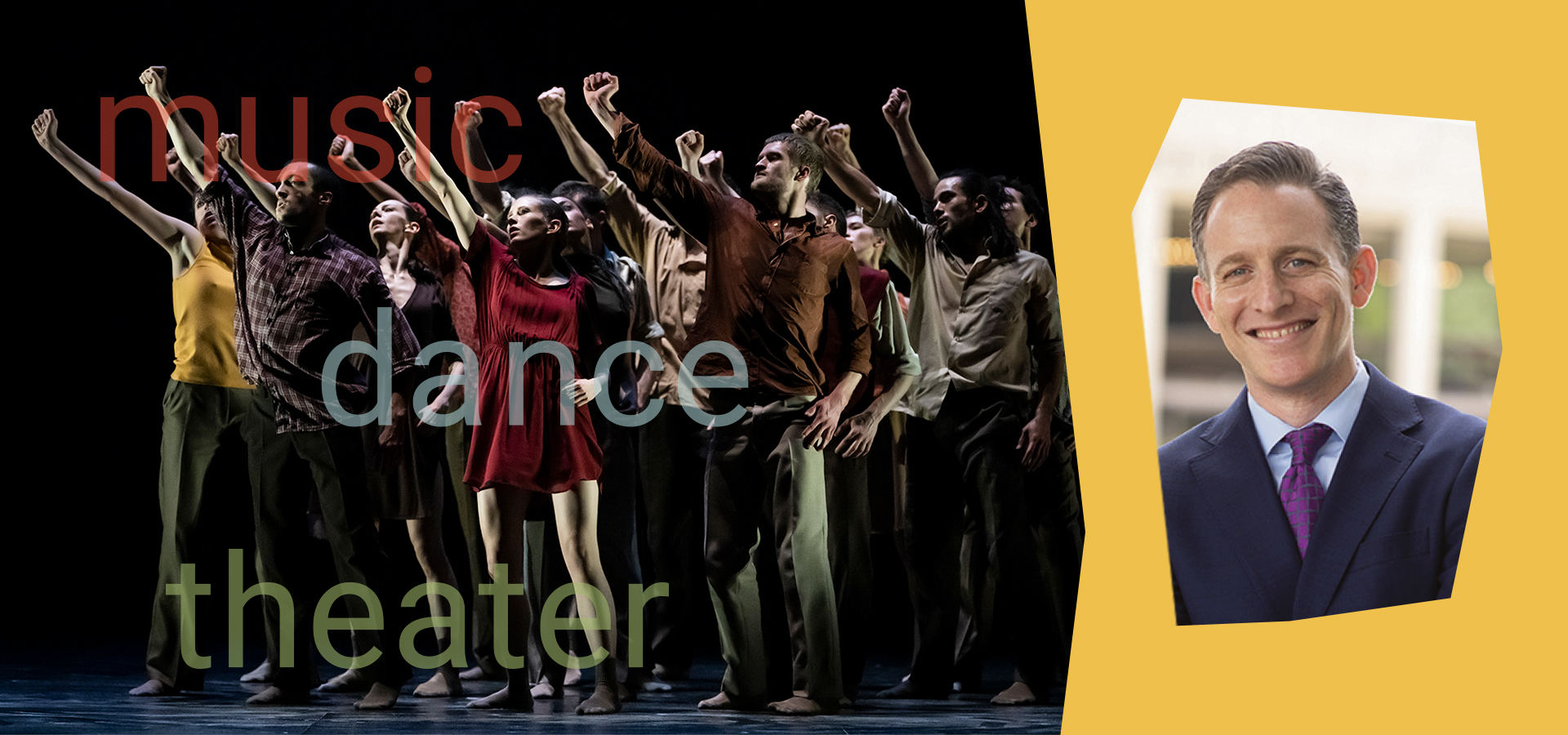
Beethoven 250: Travels with Beethoven
“In a world as unstable as the ground in earthquake country, we need Beethoven.”–Larry Rothe

Portraits of Beethoven at different ages
Eight years ago, in an article called “Beethoven’s Guide to Being Human,” I made the case for Beethoven’s power to fill his audience with optimism, his capacity to convince a listener that good will prevail. This, I admit, reduces my argument to its most simplistic components. Even back then, few would have believed the victories celebrated at the end of Beethoven’s Fifth and Ninth symphonies, or his opera Fidelio, could last beyond the final curtain. But how much has happened in these eight years. Today, when national and world events demand we re-examine and get more serious about what “being human” means, Beethoven can help.
These days we can be forgiven for imagining we live in a uniquely unstable world, where unwelcome news is dismissed as fabrication, facts possess alternatives, and even nature’s laws are questioned. But stability is always an illusion, as Beethoven knew, personally and politically. Imagine: a 31-year-old composer loses his hearing—”the one sense,” he confessed, “which ought to be more perfect in me than others.” Imagine Beethoven’s Vienna, where the freedoms left intact by Napoleon’s army were undercut by the Austrians themselves. Emperor Franz II, his ear fine-tuned by the French Revolution, heard seditious whispers everywhere, sent his spies to root out enemies of the people, and abolished the free press he abhorred. Beethoven tamed such personal and social catastrophes. Facing deafness, he rejected suicide as an option: “It was only my art that held me back. It seemed to me impossible to leave the world until I had brought forth all that I felt was within me.” He reassembled his inner resources, intent on changing things. Beethoven (writes his biographer Maynard Solomon) “was prepared to furnish [Vienna] with a model of heroism as well as beauty during an age of revolution and destruction and to hold out the image of an era of reconciliations and freedom to come.” He has done the same for the generations since. He translated his inner powers into music of virtually uncontained aspiration, music that urges us to do as he did: continue, and reject despair. Beethoven’s message is optimism, optimism hard-won but ever-present and waiting to be captured: a constant, a kind of stability.
A World in 32 Pieces
Fortunately for the Cal Performances audience, Beethoven is a focal point of this 2019/20 season as we celebrate the 250th anniversary of his birth. You will hear orchestral works and chamber music. But for the full Beethoven immersion, pianist Jonathan Biss appears in seven recitals. Between September 2019 and March 2020, Biss performs the complete cycle of Beethoven’s 32 piano sonatas.
Beethoven began composing piano sonatas early in his career and continued writing them to the end. As you might expect, given the span of years between the first and last of these creations, they encompass an artistic and emotional terrain of varied contours, ranging from lighthearted melody to cosmic statements at music’s outer limits. If you think of the sonatas as a 32-piece jigsaw puzzle that, completed, forms an image of the world, you get some idea of what’s in store.
Jonathan Biss, who has spoken of Beethoven’s sonatas as “a private diary of a genius,” is nearing the end of a nine-year project of recording the Beethoven sonatas, with the final volume scheduled for release in November. Biss is an eloquent writer, and with disarming candor he talks about his relationship with this music in Beethoven’s Shadow, an extended essay available as a Kindle e-book (but not in a print edition) through Amazon.com. (An excerpt from Biss’ writing appears in the program notes for each of his concerts.) In this personal account Biss covers a broad territory—his earliest experiences with Beethoven, his changing reactions over the years to the Appassionata Sonata, the opportunities and problems of recording, the challenges and assurances Beethoven offers a listener.
A Better World?
Count me among the multitude for whom Beethoven opened a world. His work is a point of entry and defines why we listen to “classical” music. Compared to him, every other composer comes up short if what we’re looking for is urgency and a persistent sense of necessity. In the words of British music critic Neville Cardus: “Beethoven most times was a rebel, beating his fist against the mortal limitations of music. He often wanted to say things which music couldn’t contain, let alone express…. That is why there are so many repeated notes and chords in Beethoven, violent sforzandi which are symbols of protest. Repeated notes in music, when they are strenuous and weightily harmonized, usually mean that a composer has something on his mind. He, at any rate, is not just trying to write a melody.”
Beethoven molds our sense of what we expect music to offer. No one before him had given instrumental music such narrative power, and everyone after him attempted to emulate his storytelling command. His genius was to infuse his music with psychological scenarios, to join an almost operatic concept of drama with music not limited by the words that any characters sing. The Fifth Symphony is the most obvious example of this. Tchaikovsky, who claimed his own Fourth Symphony was “a reflection” of Beethoven’s Fifth, wrote that the Fifth was based on a program “so clear that there cannot be the smallest difference of opinion as to its meaning.”
That plot, depicting a movement from struggle to victory, darkness to light, suggests that abstract music possesses an ethical component. Which is not to say that music makes us better people. That claim disintegrates in light of history’s many bad-guy music lovers. But abstract music, because it is abstract, is open to interpretation. Lacking the limits and specifics that words would impose on them, Beethoven’s unconstrained dramas engage the imagination, enlisting our gut responses to his scenarios, enabling us to grasp his messages by understanding our own reactions to him. In this, Beethoven tells us to value our own emotions. That may not make us better, but it certainly can make us happy.
The Effort and the Payoff
If Beethoven can open a wider world for listeners, the door to that world is perhaps accessed most easily through his symphonies. Besides the large and insistent gestures delivered by an orchestra—try ignoring those—we encounter theater in every Beethoven symphony: rising and falling action and climaxes, all delivered in unforgettable lines.
The symphonies tell only a fraction of the story. Big public statements can convey their messages with blunt power, but Beethoven explored most deeply in more intimate forms, especially his piano sonatas and string quartets. In those genres, particularly in the late works, he experimented with structure and devised new ways to communicate—Biss has written of “the perpetual innovation which is one of the most significant aspects of Beethoven’s output.” Beethoven ignores limits. Into his music he loads a multitude of beauties and complexities, and he trusts our anticipations and memories of both—he trusts our close listening—to ensure that his compositions will transcend their formal borders. He expands music’s capabilities.
Beethoven, says Jonathan Biss, “writes about an idealized world.” The pianist speaks of the “wonderment” he finds in Beethoven’s sonatas, as though “the search for something unreachable is part of the music’s expressive DNA.” Beethoven invested huge effort in that search, and to be true to the music, the artist must convey that effort. As Biss writes, “Without the sense that blood, sweat and tears were involved, a performance simply will not sound like Beethoven.”
Discovering the Sonatas
Even in the early sonatas you hear a new voice. Listen to No. 2. Neither Haydn nor Mozart wrote anything so highly spiced, or so delightfully narcissistic. Its self-love dictates its structure: because Beethoven can’t let go the principal theme of his third movement, it becomes part of the finale. Beethoven aims at more than what music before him could embrace, and he carried that aim to extremes in the late sonatas. For example: In the second movement of the two-movement Opus 111 Sonata, the last of the 32, we never know where he is leading. He asks that this movement be played in a “simple and song-like” way, yet no line of melody goes in a direction we expect. At the same time, he convinces us of the momentum’s inevitability. He convinces us he has captured and transcribed some essential generative rhythms. Think back to what Neville Cardus said. Rather than melody, this music is about rhythm and energy and invention.
Energy also marks the many great, tender adagios Beethoven created. In them, too, the music is not so much based on recognizable and memorable melodies as on reflection, on gesture, on beautifully uttered phrases—quietly urgent, at once rapt and taut with compressed force, sublime.
Beethoven understood the sublime, and also the absurd. As a deaf composer—what could be more unlikely?—he would have had to cultivate a sense of irony and the ridiculous. His humor could be crude. If his instrumental music included words, you can bet many of them would be spelled in four letters.
Sometimes crude and more often direct, Beethoven is also subtle. Listening to different artists approach him reveals different shadings and nuances. I recently compared recordings of the Appassionata Sonata’s first movement by three pianists. A minute into Rudolf Serkin’s recording, he attacks the keyboard, seemingly bent on destroying it. Trills that emerge as ornaments in recordings by Artur Schnabel and Alfred Brendel pinch like pinpricks in Serkin’s recording, which is only slightly slower than Schnabel’s but almost half a minute faster than Brendel’s. (Schnabel, still identified with the sonatas today, was the first to record them all, in the 1930s.) Toward the end of the movement, a racing passage is suddenly interrupted, punctuated by a downward jab. Serkin hesitates for a micro-second before the jab, and in that suspension you feel him gathering strength for the blow. Neither Schnabel nor Brendel bring a similar sense of drama to this moment. While Serkin focuses on each step in the narrative and its various characters, Schnabel is less episodic, integrating its elements more completely, emphasizing the music’s beauty. Brendel stresses architecture and balance, drawing special attention to a four-note figure that is cousin to the fate motif of the Fifth Symphony. Do these differences reflect the artists, or Beethoven?
“Who knows what ingredients go into the greatest of performances?” the film director Errol Morris asks in his New York Times essay “The Pianist and the Lobster,” proceeding to point out that “no matter how good we can ever be, we may still be chained to the wall in Plato’s cave, fantasizing about an unreached ideal.” Given such shifting ground, you might think Beethoven offers no more stability than the public figures who alter their positions with the polls. But all three pianists whose Appassionata I compared suggest what the Appassionata is, different and yet the same, there for us.
In a world as unstable as the ground in earthquake country, we need Beethoven. As we perform and listen to what Beethoven gave us, we do well to remember the deafness and illnesses he coped with, how his very act of writing represented courage in the face of considerable misery, and how that misery vanishes and that courage is mirrored in the dramas he wrote—dramas that culminate insistently or gently or even enigmatically in some ideal destination. In our lives, that ideal will remain unreached simply because it is an ideal, but traveling toward it can be good in so many ways. Beethoven invites us to join him.
Larry Rothe, who writes about music for Cal Performances and the San Francisco Opera, has written for the Chicago Symphony Orchestra, New York Philharmonic, and San Francisco Symphony. His books include For the Love of Music and Music for a City, Music for the World.



